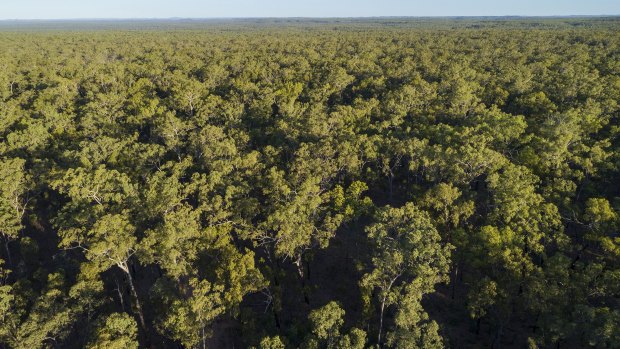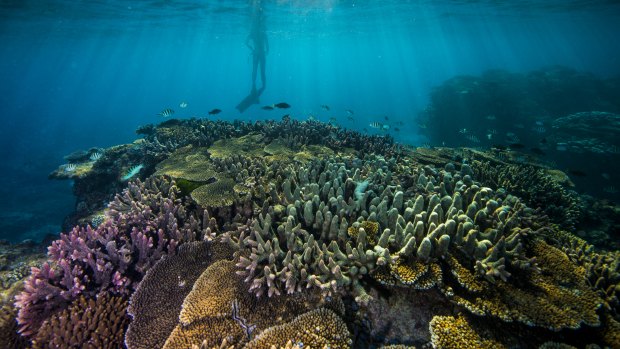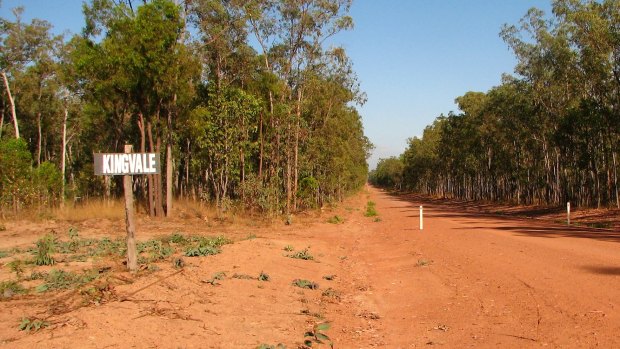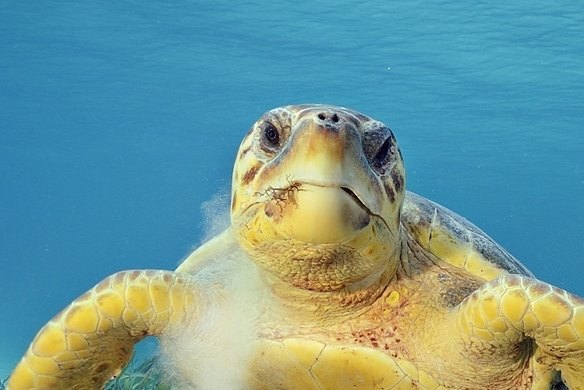- Exclusive
- Politics
- Federal
- Great Barrier Reef
This was published 5 years ago
Swaths of native forest near Great Barrier Reef set to be bulldozed
Federal officials plan to back the destruction of almost 2000 hectares of pristine Queensland forest in a move that threatens the Great Barrier Reef and undermines a $500 million Turnbull government rescue package for the natural wonder.
A draft report by the Department of the Environment and Energy recommends that the government allow the mass vegetation clearing at Kingvale Station on Cape York Peninsula. The area to be bulldozed is almost three times the size of the combined central business districts of Sydney and Melbourne.

Old growth forest in the vicinity of Kingvale Station, near rivers that flow into the Great Barrier Reef. Photo courtesy Australian Conservation Foundation.
The draft recommendation comes despite the department conceding the native forest is likely to contain endangered species, and despite expert warnings that runoff caused by the clearing may damage the reef.
Environment Minister Josh Frydenberg will make a final ruling on the proposal. It will test his long-stated willingness to protect the reef from poor water quality, which is triggered by land clearing.
Last month the government announced it would spend more than $500 million to protect the reef, including $201 million to improve water quality through better farming practices.
A rejection of the Kingvale proposal would put Mr Frydenberg at odds with Queensland Coalition MPs who have vocally backed the plan.
Kingvale Station owner Scott Harris wants to clear the land – mostly eucalypt forest and melaleuca swamplands – to make way for cropping and other activities.
The former Queensland Newman government approved the work in April 2014. However the federal government determined that the clearing must also be assessed under Commonwealth laws.

The government's own experts warned the land clearing proposal may damage the Great Barrier Reef.
The department’s draft report, on which submissions closed this week, concluded the proposal should be approved, subject to conditions. A final recommendation will be made when submissions are considered.
Conditions include that clearing be limited to 1846 hectares and only take place on flat land to “manage the risks" of erosion and sedimentation. Clearing should not occur within 100 metres of a watercourse or wetland, contour banks must be used to manage water flow and erosion should be repaired before each wet season.
The proponent told the department the land clearing would not cause damage to the reef.
The clearing is proposed on land that drains into two rivers that run into the Great Barrier Reef 200 kilometres downstream.
The draft recommendation comes despite a government-commissioned expert warning that soil erosion from the work was “likely to contribute to poor water quality” in the reef world heritage area.

Forest at the Kingvale Station, where more than 1800 hectares is set to be cleared. Photo courtesy Australian Conservation Foundation.
The Great Barrier Reef Marine Park Authority also said that during floods the clearing “is almost guaranteed” to result in fine sediment entering Princess Charlotte Bay, where the rivers meet the reef.
Poor water quality is one of the most pressing problems facing the reef. It is largely caused by nutrient, pesticide and sediment run-off from agriculture. It can cause algal growth at the expense of coral, block light and smother corals, as well as exacerbate outbreaks of the venomous crown-of-thorns starfish, which are a major cause of coral loss.
The department also concluded that the clearing would affect a host of endangered species including the Northern quoll, and loggerhead and leatherback turtles.

The department said endangered loggerhead turtles may be affected by the proposal.Credit: Brian Skerry/National Geographic
Despite the concerns raised, the department concluded the likely impacts of the clearing “will not be unacceptable” if conditions were adhered to.
The department said the proponent had been charged in Queensland over illegal land clearing at another of his properties, Strathmore Station. But because the charges had not been heard by a court, the department “does not have evidence that the proponent has any established unsatisfactory record of environmental management”.
The department has been under political pressure to green-light the proposal.
In August 2016 then Minister for Agriculture Barnaby Joyce said there was insufficient evidence to determine that the clearing would damage water quality in the reef.

Environment Minister Josh Frydenberg will make a final ruling on the proposal.
The same month, Northern Australia Minister Matt Canavan told The Australian newspaper that landowners should not have to face two levels of environmental assessment, adding that the federal scrutiny of the Kingvale plan discouraged development.
Cairns MP Warren Entsch told the newspaper he had contacted Mr Frydenberg to “ask what the bloody hell is going [on] ... you can’t get development in these areas without land clearing’’.
Australian Conservation Foundation policy analyst James Trezise said it was “astounding” that the government was pouring money into water quality improvements while planning to “wave through more of the destruction causing the damage”.
He said approving the proposal would also set a dangerous precedent by deeming that tree clearing on flat land did not pose a runoff risk.
The Wilderness Society’s Queensland campaign manager Gemma Plesman said the proposed clearing was “incredibly risky”.
“Over the past four years Queensland has cleared one million hectares of native vegetation because the former Newman Government axed important environment protections. This bulldozing plan ... must be rejected,” she said.
A spokesman for Mr Frydenberg said the department’s draft report “proposed strict conditions and mitigation measures informed by expert scientific advice”.
All feedback will be considered by the department as it finalises its recommendation, he said.